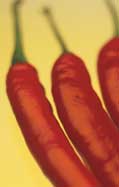Fire Starters

This stereotype is being radically revised by today's chefs, who are creating a new role for barbecue by adapting a global perspective and menuing barbecue items as starters. They're serving not only American favorites, but Jamaican jerk, satay with peanut sauce, Asian barbecue and Latin American sausages. And they're putting barbecue items on the menus year-round.
Many are using creative barbecue starters to whet appetites and encourage trial, while others see starters as a way to have some fun with traditions. “With starters, you can use an application that someone might not try as an entree,” observes Chris Ward, executive chef-partner of the Dallas-based Restaurant Life Group. And small-portion premieres of familiar classics such as baby-back ribs or pulled pork—or more unusual, flambeed chorizo—offer patrons a chance to sample more than one tasty treatment in a sitting.
Steven Raichlen, author of “The Barbecue! Bible,” notes that one manifestation of barbecue's exploding popularity is “high-falutin' chefs reinterpreting down-market barbecue foods.”

At Home Anywhere
Perhaps as a response to the boom in appreciation for regional American cooking, traditional barbecue is showing up year-round and far afield from its origins. Danny Meyer (co-owner of Union Square Cafe and Gramercy Tavern, among others) recently opened Blue Smoke in New York, offering Manhattanites a variety of smoked meats in varying regional styles.In Beverly Hills, former Tampa Bay wide receiver Keyshawn Johnson's contemporary Southern restaurant, Reign, serves a down-home appetizer of charcoal-smoked Old School Kansas City-style barbecue baby back ribs, using a family-secret tomato-based sauce with molasses and beer.
“Barbecue taps into a patriotic pride, as well as a deep appetite for things that are enduring and real,” Meyer says.
Indeed, true regional barbecue is uniquely American, with roots in the festivals and social rituals of the Old South. The Southern “barbecue belt” shares the tradition of slow-cooking the meat, with variations on smoking, pits or spits, and usually one of the regional (and micro-regional) sauce and/or rub styles—the relative merits of which are hotly debated.
Practical Advantages
Romanticism aside, barbecue offers the practical benefits of using lower-cost cuts and holding well for catering. And, notes chef-owner Ben Barker of Magnolia Grill, Durham, N.C., “While barbecue is not easy to do, once you get the systems down, you can replicate them fairly consistently from day to day, so it makes good sense from an operational standpoint.”Barker (license plate: PIGDADDY) “plays with pork a lot.” One of his popular permutations, a surf-and-turf starter he calls “a generous dosage of Dixie on one plate,” consists of three grilled Carolina white shrimp atop pulled pork barbecue, plated with three smoked baby-back ribs, creamy slaw, corn relish remoulade, corn sticks made with bacon, and Vidalia onion mustard. Barker's use of cole slaw and cornmeal echoes the time-honored slaw-and-hush-puppies accompaniments ($10.50).
Barker uses a drum smoker with a separate firebox, in which he can do hot or cold smoking (he typically slow-smokes at 175° F to 200° F. His baby backs are dry-rubbed, smoked for two hours, and slow-cooked overnight for eight hours at 200° F on a rack in the oven “so the fat falls away.” Prior to plating, he brushes them with a sourwood-honey, cider vinegar and red pepper flake glaze and finishes them on the grill.
Atlanta-based Chef David Berry takes another approach to those rustic roots. Berry likes the fat-to-meat ratio and bone-in flavor of pork shoulder. He hickory-smokes for 12 hours at 250° F, then pulls the fat out before shredding the meat, which exhibits a “velvety, silky texture.” He uses North Carolina-style, vinegar-based barbecue sauce, puts the pork on a cornmeal pancake, adds a dollop of slaw, and drizzles with a tangy, tomato-based sauce containing molasses and brown sugar.
Among the “Southern comfort food” at Chicago's Creole, the pan-smoked pulled pork is doused with a vinegar-based cola BBQ sauce. Chef Bruce Evans suggests this as a saucy starter served on buttermilk biscuits ($4.95).
James Beard award-winners Debbie Gold and Michael Smith take the traditional Memphis dry-rub to new heights with an intriguing, aromatic spice-rubbed pork brochette. At 40 Sardines in Overland Park, Kan., they plate the brochettes with chanterelles, red onion grits and a red wine glaze.

World View
Exploring more global terrain, popular pork starters include Jamaican jerk, satay with peanut sauce, and grilled sausages with onions and bell peppers. More esoteric preparations might include an Asian variation, pan-smoked over high or low heat with soaked tea leaves or moistened wood chips.At Citizen in Dallas, Chef Chris Ward's glazed, Asian-spiced rib starter is plated with a shredded carrot-daikon salad in a rice wine vinaigrette ($11). He also roasts whole suckling pigs on a wood-burning rotisserie, serving the sliced meat in a soy, honey and natural stock reduction sauce with rice pancakes. “It's similar to Peking duck,” he says, “with the crispy skin and succulent, tender meat. I can sell it as appetizers all day long.”
At New York's Portuguese fine-dining restaurant Alfama, chourio (smoked pork sausage) is flambeed in Portuguese moonshine and served with a dense cornbread and an olive oil, chopped parsley and garlic sauce for dipping. A simpler version of grilled pork sausages might be drizzled with a brandy or bourbon sauce and served with American cornbread.
Chef Johnny Vinczencz of De La Tierra at the Sundy House in Delray Beach, Fla., does a “new Florida” grilled pork tenderloin marinated in ancho chile, cinnamon, and roasted-garlic. A three-ounce portion is plated with sweet potato-chorizo hash, drizzled with a barbecue demi-glace and topped with fried leeks.
The creator of Nuevo Latino cuisine, Douglas Rodriguez, chef-owner of New York's Chicama and Pipa and Philadelphia's Ama de Cuba, offers an intriguing grilled sugarcane-skewered pork tenderloin with Costa Rican coffee glaze.
Christina Hernandez, chef-owner of Sabor in Schaumburg, Ill., suggests some juicy tropical treatments for grilled pork, including guava glaze with papaya fruit or a pineapple-rum mojo ($7-$7.50).
With so many appetizing options, it's easy to see how barbecue's many guises represent a great way to make a lasting first impression.
Alice Van Housen is the editor of the 2003 Chicago Zagat Guide. She is also the editor of Local Palate.

Sidebar: For Starters
Plate was developed to serve a menu revitalization effort in restaurants and other foodservice venues. “It might seem basic on its surface, but after years of investing new unit growth, theme restaurants or Wall Street IPOs, many foodservice companies are rediscovering that it's the food that really matters,” says Bill McDowell, editorial director. “Many of the chefs we interviewed said they aren't getting the kind of practical ideas and food trend information they need from other trade publications.”The first issue includes more than 40 chef-authored recipes, all edited to professional cookbook standards. “Plate is all food, all the time,” McDowell says. “But we want it to be a practical, too. We've recruited an all-star team of food writers and photographers to capture emerging trends and translate them for a broader audience of foodservice operators at all price and service levels.”
Editorial for each issue is built around a specific food category. The debut issue, sponsored in part by the National Pork Board, explores menu applications for pork. Future issues will focus on beef, poultry and seafood as well.
“We examine the featured subject from all angles of the menu, from appetizers to entrees, but we also explore complementary side dishes, desserts-even beverage pairings,” McDowell says. “We hope this 'whole menu' approach will make Plate a lasting tool that chefs will revisit over time.”
The new quarterly reaches an audience of 24,000 chefs and menu influencers in R&D, marketing and purchasing departments of independent restaurants, chains and foodservice management firms. “We believe that Plate's targeted audience and unique editorial approach create a very efficient tool to reach this market,” says Steven Mayer, publisher. “This small group of professionals actually drives menu development for more than half the foodservice industry.”
For more information about Plate, visit ,www.plateonline.com or call 312-274-2211.
Sidebar: Sauce Sorcery
Author Steven Raichlen has “logged hundreds of thousands of miles” on the barbecue circuit. Here's his take on basic regional sauce styles, “elusive” intra-regional nuances notwithstanding:Kansas City:
Thick, red, tomato-based sauce that's sweet and smoky (liquid smoke).
North Carolina:
Puckery, peppery vinegar sauce. (Notes North Carolina chef Ben Barker, “ It gets sweeter and more tomato-oriented as you go
farther west.”)
Memphis:
Predominance of dry rubs and a range of tomato and vinegar sauces of varying sweetness.
Texas:
“Bold and no-nonsense” sauces based on ketchup, vinegar, meat drippings, water and “chile hellfire” (and sometimes a little sugar).
South Carolina:
Yellow mustard-based sauce.
Sidebar:Smokin!
Hot-smoking: Provides flavor and cooks the product. Smoke sausage products at 160° F, solid meats at 185° F to a resulting internal temperature of 155° F.Cold-smoking: Imparts smoky flavor without cooking the product (may result in some dehydration of overall texture). Smoke at 70° F to 100° F (use for sausage and pork to enhance flavor, or to pre-prep an item such as pork loin that will later be roasted or grilled).
Pan-smoking: A quick method over an immediate heat source (stovetop of grill). Create a small insert pan with wire rack placed on wood chips, sawdust, tea leaves, herbs, etc.
Source: Certified Master Chef Victor Gielisse, associate vice president of The Culinary Institute of America.
Sidebar: Pulled Pork with Cola
Low country pulled pork with cola BBQ sauce on buttermilk biscuitChef Bruce Evans, Creole, Chicago
Yield: 14 servings
5 lb Pork butt, fresh
12 oz Cola
1 TBS Fresh lemon juice
1/4 C Butter
1/4 C Sugar
4 oz Garlic, minced
Salt to taste
42 each Buttermilk biscuits
2 each Fresh rosemary sprigs
2 each Fresh thyme sprigs
Hickory chips, soaked for 15 minutes in cold water, as needed
1. Set up smoking pan with hickory, rosemary and thyme. Cover with rack and set over low flame. Place pork on rack and cover tightly. Smolder for 30 minutes.
2. Saute garlic in butter in a braising pan over medium heat. Add pork, fat side down, and brown thoroughly on all sides. Add cola, lemon juice, sugar and salt and cover tightly. Roast in oven at 350° F until pork is tender, about 2 1/2 hours. Remove, strain sauce and reserve. Pull pork and reserve.
3. To serve: saute 12 ounces pork mixture in a hot pan, blend in 4 ounces sauce. Place 1.5 ounces of pork on each biscuit, allowing three per serving.
Notes: A range-top smoking pan can be improvised using two hotel pans—one as the bottom pan and one as the lid.
Menu price: $4.95; food cost/
serving: $1.28
Looking for a reprint of this article?
From high-res PDFs to custom plaques, order your copy today!



